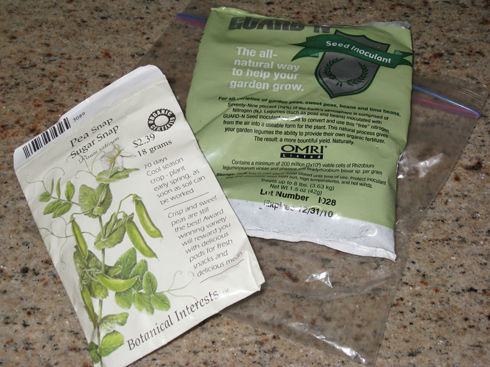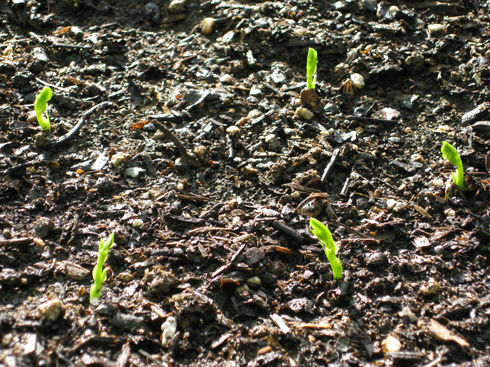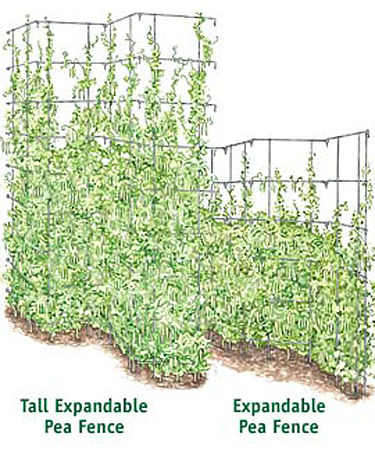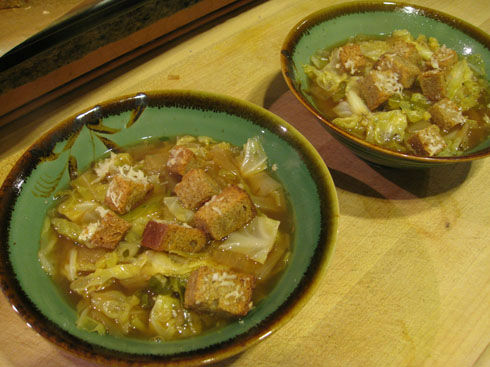Most people grow peas in the spring. I like to grow them in the fall. I think I started growing them in fall primarily because, A) we can, and B) I need my trellises for other things in the spring. Over the years peas have become a prominent part of my fall garden, lending height and tastiness to fall garden chores.
They never make it into the house. A few are picked and gobbled up while looking for cabbage worms on brassicas. A handful get put into my pocket, with good intentions of being saved for later. Inevitably the pocket empties as my stomach fills with the sweet, crunchy flavors of home grown goodness. For those in warmer climates, there is still time to put a few seeds in the ground. Here’s a step by step to get you started:
First – start with inoculant. What the heck is that, you ask? Bean and Pea Inoculant is a collection of rhizobacteria that allows your beans and peas to pull nitrogen from the air and turn it into usable nitrogen in the ground. It can get pretty technical, but here’s a good explanation from Colorado State University Extension Service:
“The air we breathe contains more than 78 percent nitrogen in theform of nitrogen gas (N2). Legumes have the unique ability toform a symbiotic relationship with rhizobia (Rhizobium andBradyrhizobium) bacteria to convert atmospheric nitrogen gas toammonia nitrogen, a form usable by the plant. This relationshipoccurs in specialized root tissue called nodules.”
Second – Soak your peas over night or at least 8 hours. That will take about 2 days off the germination process. Place soaked peas in a container. The water from the soaking will probably be all you need to mix in the inoculant.
Next – sprinkle your soaked peas with powdered inoculant and swirl to coat.
After that – you’re ready to plant. You can plant peas directly in the ground or indoors. We started our first (and second) batch in the garden, but our current rodent issues have been cause for alternative action. Plant your seeds as deep as recommended on the seed packet – usually 1″ is good. I push them down a little deeper because the seeds tend to lift as they sprout.
Peas can be planted about 3-4″ apart (some say as close as 2″).

Pea sprouts
Don’t forget your trellis – If planted directly in the garden, I highly recommend placing your trellis first, then planting around it. You’ll be glad you did later on. I like to plant seeds on both sides of the trellis sothat when they grow big and tall, that balances the weight equally andthe trellis is less likely to fall over. The one I recommend to all of my clients is the Tall Expandable Pea Fence from Gardener’s Supply:
In 5-10 days you’ll see sprouts poking up out of the soil, as above. As they grow, the leaves begin to unfurl and look more like pea tendrils as we known them.

Pea seedlings ready for planting out into the garden
At this point, these sprouts are ready to plant out into the garden if started indoors. Lift them out gently with a pencil or widger or a thin hand trowel. Dig a deep hole to accommodate the roots and bury slightly lower than the existing soil level. Water gently to settle the soil, rather than compressing it by hand.
Some peas need extra protection from the elements or vermin until they get established. We’ve created an enclosure that will be clothes-pinned to the trellis to keep our pea sprouts safe from harm. But that’s a story for another day…
Stay Tuned!




Pingback: YouTube: How to Grow Sugar Snap & Snow Peas Start to Finish - Gardenerd
Pingback: YouTube - Quick Crops for a Coronavirus Garden - Gardenerd
Pingback: YouTube: Spring Planting Guide - Gardenerd
I really like your pea fence diagrams! I am planning on using pea fences for my peas next year! I had never heard to use an inoculant before, thank you for the great information to implement next year!!
Tina Martino
https://www.gardenloka.com
Pingback: Gardenerd: Organic Edible Gardening | Pea Protection
organic soap
[…]Gardenerd: Growing Peas – The Garden Snack Food[…]
Love this article! Just this morning on my way to work, I stopped to pick a few snap peas from my fall garden. A fun and satisfying snack, to be sure! Thanks for the additional tips.
Thanks for the pea planting hints. I planted my peas without soaking last spring and they grew fairly quickly. Helping them to reach maturity even quicker works for me, I’ll try it w/my fall/winter garden.
Best,
Esther
Great Article!